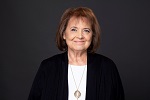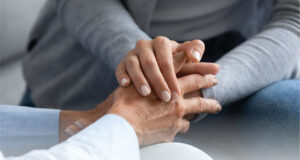
The Beauty and Power of Nursing
BY MICHELLE KNAUB, MED, BSN, RN
Most of you are nurses, and I ask you to think back to when you were still “working the floors.”
Did you ever have a day when, even though you were bone-tired and so very glad to be going home, you still felt energized and alive? I believe if you think back to the patient interactions that occurred during that shift, you will remember at least one very special encounter. I would like to share one such experience I had that helped me understand and appreciate the beauty and power of nursing.
As the case manager for women’s services at a busy local hospital, I met with all teen moms, after they had given birth, to assess their support systems and discharge needs. During my first meeting with Susan (not her real name), an 18-year-old postpartum patient, it became apparent that she had financial problems. She did not have a car seat, had very few baby supplies and shared that she was worried how she would pay for baby formula. Susan was married to a nice young man, and while the young couple loved each other and were very happy with their new baby, it was apparent they were struggling to make ends meet.
A woman has usually decided if she will breastfeed or bottlefeed by the time she delivers, and I always felt I should respect their decision and support whatever mode of feeding they chose. During pregnancy, the topic of breastfeeding is discussed with their doctors, and the nurses address it as well upon admission, so the decision to breastfeed or bottlefeed is well established by the time of the first case management interview. But, after meeting Susan and learning of her financial difficulties, I felt a moral imperative to step over that thin, invisible line to ask, “Why aren’t you breastfeeding, dear?”
Breastfeeding is superior nutrition for a newborn; it is convenient, and especially pertinent to this case, it is free! Susan made a face and replied, “I heard it hurts.” I assured her that I had breastfed my baby and it did not hurt me. I pulled up a chair and as we talked about the benefits and the usual ease and convenience of breastfeeding, I could see the glimmer of hope and excitement start to grow in her eyes as the possibility of breastfeeding started to become a reality.
I asked Susan if she had discussed breastfeeding with her nurse; she made a disgusted face and said, “Oh, her. She doesn’t want me to ask her anything.” That was distressing to hear, but true or not, it was Susan’s perception, so I asked her if she would like to speak with the lactation nurse and she replied, “Yes.” I found the lactation nurse, described the situation and asked her to meet with Susan as soon as possible to keep the fire of possibility alive. Joan, the lactation nurse, was also excited at the possibility of Susan becoming a breastfeeding mom and agreed to meet with her prior to the baby’s next feed.
When I met with Susan the next day, she was breastfeeding and was so happy to tell me it was going well and that it did not hurt! She seemed to be taking a new pleasure in her mothering, and the baby was nestled in her arms, sucking for all he was worth.
The pleasure hormones released by breastfeeding had kicked in, and Susan was a new woman: it was immensely rewarding to see this young mother go from a position of fear and uncertainty to one of power and strength.
I’ll never forget the look on Susan’s face when she was discharged from the hospital. She was sitting straight and tall in the wheelchair, with her baby in her arms and a huge smile on her face. Her young husband was by her side, and Susan was taking a joy in her motherhood that was beautiful to see. She felt powerful and was absolutely radiant. As I hugged her goodbye, she looked and me and said, “Thank you.” I watched the new family leave the hospital and felt a sense of accomplishment that thrills me to this day when I think about it.
There are many ways to practice nursing, to know your patient and to answer their calls for nursing. In 1978, nursing professor Barbara Carper published a paper in the very first issue of Advances in Nursing Science based on her doctoral thesis entitled, “Fundamental Patterns of Knowing in Nursing.” Dr. Carper felt nursing curricula had become overly focused on science, and her paper sought to illustrate that what was essential to the practice of nursing entailed a great deal more than science. Nurses use empirical knowledge to care for their patients, but we all know empirical knowledge by itself is only part of the picture. Dr. Carper explored nursing theories, published works about nursing, and her analysis revealed a pattern and structure to the practice of nursing that often occurred simultaneously, subconsciously and without words. She labeled these other dimensions of nursing “patterns of knowing” and proposed that the four patterns work together to illustrate how nurses know patients and how to care for them.
For those of you unfamiliar with Dr. Carper’s work, these patterns of knowing are:
- Empirics, the science of nursing
- Aesthetics, the art of nursing
- Personal, the therapeutic use of self
- Ethics, the moral reasoning base of nursing
Her paper outlined a major new nursing philosophy and paradigm that helped nurses understand what it means to nurse and the importance of using your authentic self to create a powerful, healing encounter in which both the nurse and the nursed are transformed. Nursing is a holistic, dynamic process, and each moment between the nurse and patient is unique and has the potential to be a learning moment. Based on that moment, along with what is meaningful, a plan comes together, and the “art of nursing” is realized.
As the nursing situation with Susan unfolded, we both came to know and trust each other as women and mothers. Empirically and personally, I knew breastfeeding was better for Susan and her baby. I also felt an ethical responsibility to help Susan realize the benefits and value of breastfeeding because she had made her decision not to breastfeed out of fear rather than true personal preference. By being receptive and willing to try breastfeeding, Susan allowed me to help her, and together we participated in a meaningful process of exploration that focused on what might be. By helping Susan find her strength as a mother and as a woman, I was strengthened as well.
I started my nursing career with an associate of science degree, and although I loved nursing from the beginning, it wasn’t until I went on in school to study different nursing philosophies and theories that I understood and had the words to express why I loved nursing and why it made me feel so good. I came to realize it was because I was using the best parts of myself every day. Susan and I were both enriched by this nursing encounter. Susan was enriched because she went from a position of fear and weakness to one of power and strength. I was enriched because I was called upon to use attributes such as empathy, trust and hope: attributes that are what make us human, attributes that make us self-actualized. The caring encounter between the nurse and the one nursed transformed us both and that is the beauty and power of nursing.
Reference
Carper, B.A. (1978). Fundamental patterns of knowing in nursing. ANS, 1 (1): 13-24.

Michelle Knaub, MED, BSN, RN, has been in the nursing field for over 30 years, working the past 25 years as a case manager specializing in women’s health, NICU and pediatrics. Michelle is now retired from hospital case management and looking forward to answering the calls of nursing at a more leisurely pace. She can be reached at [email protected] with any questions or comments.


